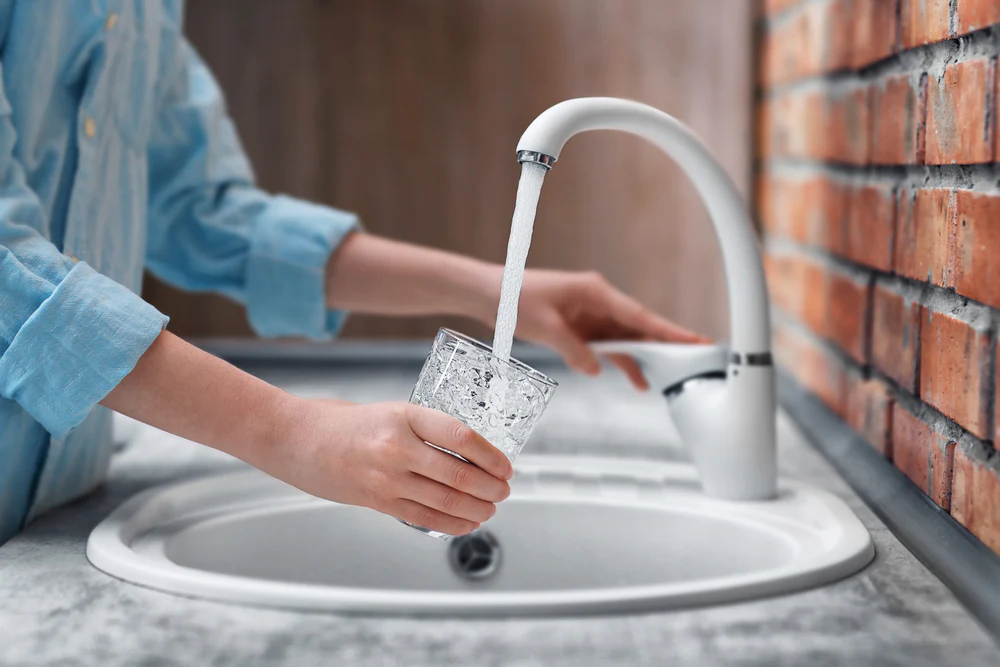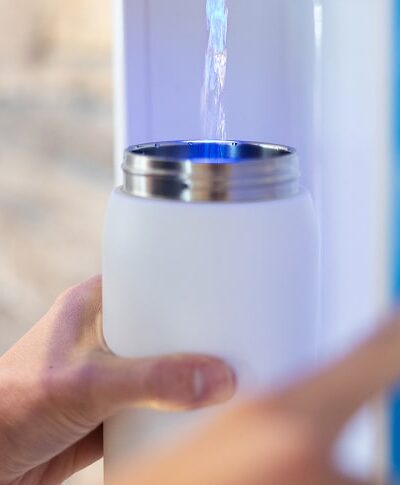Kids are notorious for not letting fear of nasty germs get in the way of their play. After all, what fun is it playing with freshly sanitized blocks when you can get your hands on muddy playground earthworms and forgotten pennies and nickels?
That’s why schools need to be especially careful when sanitizing their carpets, desks, and bathrooms. However, despite the efforts of teachers and staff disinfecting unwanted germs, some surfaces in a school environment are significantly more dirty than others and may need special attention.
Specifically, high-touch surfaces and objects easily harbor bacteria and viruses that can make students and teachers sick. In this article, we’ll answer two key questions: where are the germiest places in school? And what can you do to keep yourself and your students healthy?
#1 Water Fountains
The germiest places in school aren’t what you might expect. It’s not the highly-visited bathrooms or the sweat-filled gymnasium, nor the grime-packed playground or the food-stained cafeteria table.
It’s the water fountains.
Both health officials and scientific studies agree that drinking fountains are the germiest places of any surface in schools. Kids have an unfortunate tendency to put their mouth directly on the spigot, meaning that bacteria from their saliva stays on the nozzle long after taking a drink.
Even if children keep their mouths a few inches away from the water fountain spigot, water can still splash out of their mouth and back onto the surface of the water fountain, which can collect germs. When the next kid takes their turn, these germs can splash directly into their mouth or eyes when they lean down to take a sip, which can contaminate children with contagious illnesses like:
- Common cold
- Stomach flu
- Strep throat
- Pink eye
Cleanly Tips and Tricks
The issue with water fountains is as clear as the water that comes out: each kid drinks from the same fountain. If the fountain is rarely cleaned, it can easily harbor bacterial growths and harmful contaminants that may leave kids feeling weary rather than refreshed. In particular, lead in school drinking water has remained a topic of concern due its high levels of toxicity. Though there are many benefits of drinking water in school, conventional water fountains aren’t necessarily supporting student health.
The solution? Water bottle refilling stations.
Innovations in water purification technology have led to products like the FloWater Water Refill Station, which filters and purifies regular tap water. FloWater’s seven-stage purification system removes:
- Sediments
- Bacteria
- Viruses
- Heavy metals
- Harmful chemicals
- Other contaminants
Water bottle refilling stations cultivate clean, great-tasting water. They’re also self-sanitizing, using activated oxygen to clean the stainless steel tanks and internal systems to save school janitors some extra time and keep the entire system spotless and hygienic.
#2 Bathroom Door Handles
If you’ve ever been around kids, you know how forgetful they can be, excited to hurry on to the next exciting activity. However, forgetting to wash their hands after using the bathroom can soil the bathroom door handle, making it one of the dirtiest surfaces in schools.
Even if kids remember to use soap and water, and recite the “Happy Birthday” song when washing hands, they may still miss a few microbes and particles that can affix to doorknobs and locks when exiting the room.
Handles, locks, and knobs are less frequently sanitized than other bathroom parts, despite being high-touch surfaces. That’s because they’re not usually the first thought when planning a bathroom sanitation strategy. Often, stall locks, doors, and toilet seats are the target of many disinfectant sprays and gels, leaving door handles in the literal dust.
Cleanly TIps and Tricks
To mitigate grimey door handles and hand-to-handle contamination, consider:
- Establishing healthy bathroom habits with your children
- Supplying your students with a disinfectant wipe for trips to the bathroom
- Disinfecting any door handle and locks between visits
#3 Cafeteria Trays, Lunchboxes, and Tables
Many children love to play with their food, but there’s nothing fun about germy eating surfaces. You’d think that school cafeterias were kept extra-clean due to increased hazards, but this is frequently not the case.
Germs that live on the lunch table, shared lunch trays, and private lunch boxes all mingle together in the cafeteria to form a smorgasbord of bacteria and virus-laden surfaces. While lunch trays and tables are usually cleaned in-between uses, they may not be thoroughly sanitized or disinfected.
For example, the surface debris may be rinsed away, but depending on the cleaning method, certain germs can live to see another day.
Additionally, when eating with their hands, children will often carry germs from their trays, tables, and lunchboxes into their mouths, spreading illnesses throughout the student body.
Cleanly Tips and Tricks
If you’re a teacher or cafeteria staff, there are a few things you can do to mitigate the spread of germs or viruses, such as:
- Make sure students stay vigilant about washing hands before and after lunchtime.
- Check how well cafeteria trays and tables are being cleaned to ensure the surfaces are thoroughly sanitized and disinfected to remove dirt, bacteria, viruses, and any other unwanted germs.
- Encourage students to bring their own lunches and avoid sharing with friends.
#4 Classroom Desks
Students sit at their desks for six hours a day, five days of the week throughout the nine-month school year. That means their hands frequently touch these surfaces after recess, lunchtime, and gym class, which can contaminate desktops, pens, and pencils with bacteria and other germs.
Coughing, sneezing, touching, and even breathing sheds additional bacteria onto their desks, ready to be picked up by the next student who sits there during a group project or an end-of-day game.
Furthermore, if students are rotating classrooms, multiple kids will sit at the same desk, increasing the potential for contamination. If desks aren’t cleaned in-between classes—which they rarely are—bacteria can easily travel from student to student.
Cleanly Tips and Tricks
Desks can quickly gather a deluge of germs and bacteria. However, it’s relatively simple to keep desk surfaces clean throughout the day:
- Wipe or spray desktops with disinfectant in-between classes.
- Encourage students not to eat at their desks or touch their faces and mouths during class.
- Provide hand sanitizer in the classroom for students to use when entering and exiting the classroom.
#5 Shared Classroom Supplies
Classrooms, particularly those that house younger children, utilize a wide variety of craft supplies and learning tools for projects and activities. Many teachers will provide communal supplies that any student can use, including:
- Pencils
- Crayons
- Markers
- Rulers
- Erasers
- Scissors
- Books
- Pencil sharpeners
When students share these objects, they inadvertently spread germs between each other through touch. Furthermore, some of these objects are hard to sanitize. For example, crayons and book pages may disintegrate if wiped down with disinfectant.
Cleanly Tips and Tricks
It’s important to ensure every student has access to the supplies that they need to learn. However, teachers who provide communal supplies should sanitize them frequently—ideally, every day after the final class is dismissed. Parents can also provide their children with school supplies for individual use to avoid the spread of germs.
#6 Computers and Keyboards
Like shared classroom supplies, communal computers and keyboards are high-touch objects that many students use, and they rarely (if ever) get cleaned. Whether they’re housed in a computer lab or stored on a mobile storage cart, these devices are hotbeds for bacteria and viruses—and we’re not talking about computer programs.
For example, before the first class of the day, a student may take a quick trip to the restroom. Whether they forget to wash their hands or touch a contaminated surface, those germs can then transfer into the crevices and surfaces of keyboards, mouses, and computer monitors.
As each bell rings and a new assemblage of students roll in, the germs can continue to spread to other students. Pretty gross, right?
Cleanly Tips and Tricks
To mitigate the spread of germs between students, it’s crucial to clean touchscreens, keyboards, and mouses in between uses by:
- Applying a microfiber cloth to surfaces to collect debris
- Cleaning all surfaces with a disinfectant wipe
- Avoiding cleaning materials such as paper towels or rags that may scratch the surface of a computer monitor or deposit additional contaminants
#7 Backpacks and Phones
Backpacks and phones pack a stronger germ-tainted punch since they travel back and forth from school and home. Backpacks often carry germs and debris from the bathroom, classroom, and school bus flooring—not to mention the bacteria-breeding confines of a school locker.
In the same vein, phones are often an extra appendage to students, being carried to bathroom stalls and cafeteria tables where they can collect germs that can then be spread when sharing an especially rumor-worthy TikTok with friends during their free time.
There are many opportunities for backpacks and phones to gather and spread potentially harmful germs throughout a school.
Cleanly Tips and Tricks
If personal items like backpacks and phones are never cleaned, they’re perfect vehicles for bacteria and pathogens. As such, students should abide by the following:
- Wash backpacks frequently. If you can’t toss it in the laundry machine, wipe it down with disinfectant.
- Phones can and should be disinfected every day with wet wipes or disinfectant sprays.
While you’re at it, consider the other objects that travel back and forth to school—lunch boxes, water bottles, and notebooks should be cleaned regularly to avoid contaminant build-up.
Stop the Spread of Germs with FloWater
If you’re concerned about the bacteria and viruses that lurk on school surfaces, sanitize frequently and generously. While surfaces and school supplies can be cleaned quickly with a quick spritz and wipe of a rag, drinking surfaces like water fountains aren’t that easy.
Water fountains can be cesspools of internal and external contaminants, amassing over 800 times more bacteria than a school toilet seat (talk about being in bad waters!)
Upgrade your school’s outdated and dangerous water fountain with FloWater’s Water Refill Station, a safe, clean, and touchless alternative to drinking fountains. Plus, they’re fast, filling up a 24-ounce bottle in just nine seconds.
In a school environment, it’s difficult enough to keep your students safe and out of trouble. You shouldn’t have to worry about the quality of your water, either. With FloWater, you won’t have to. For more information on the importance of water filtration, visit our website today.
Sources:
NSF. Germiest Places at Schools. https://www.nsf.org/blog/consumer/germiest-places-schools
CNN. Top 8 germiest places in school. https://www.cnn.com/2013/08/15/health/gallery/school-germ-zones/index.html
Lysol. School Germs: Top 5 Germiest Places at Schools. https://www.lysol.com/clean-and-protect/tips-for-parents/back-to-school/school-germs-top-5-germiest-places-at-school
Microbiologics. 7 of the Germiest Things in School. https://blog.microbiologics.com/7-of-the-germiest-things-in-school/
Opposing Views. Most Germs at School: Cafeteria Table, Computer Mouse. https://www.opposingviews.com/health/new-study-reveals-germiest-hot-spots-at-school
City of Winchester Virginia. The 10 Germiest Back-to-School Places. https://www.winchesterva.gov/sites/default/files/documents/safety/10-Germiest-Back-To-School-Places.pdf





